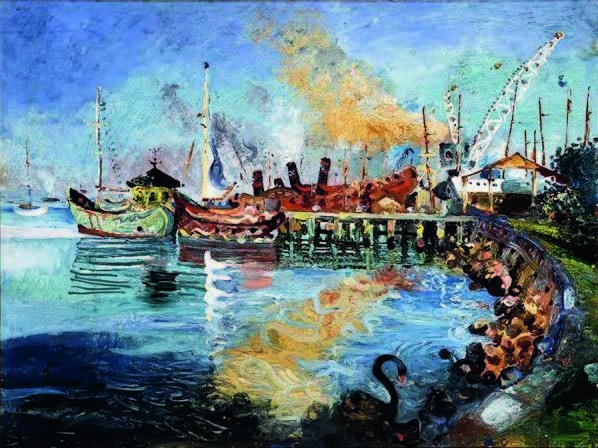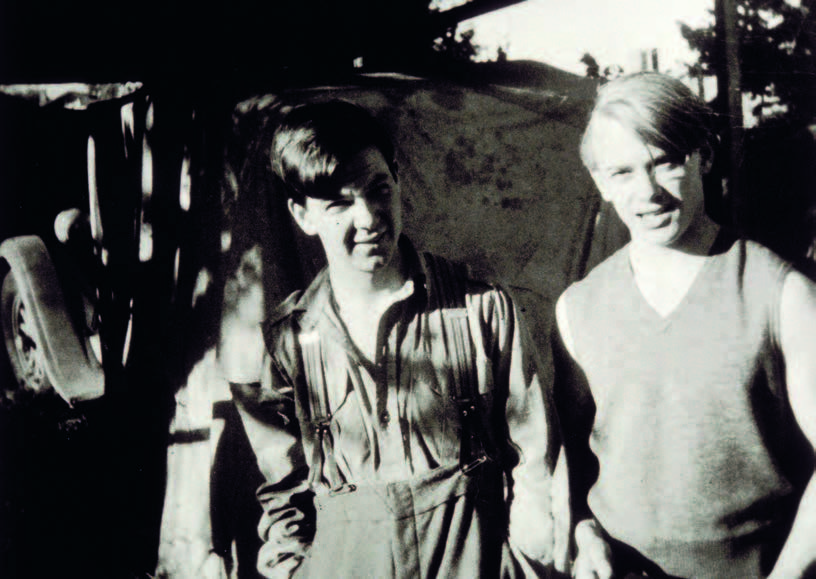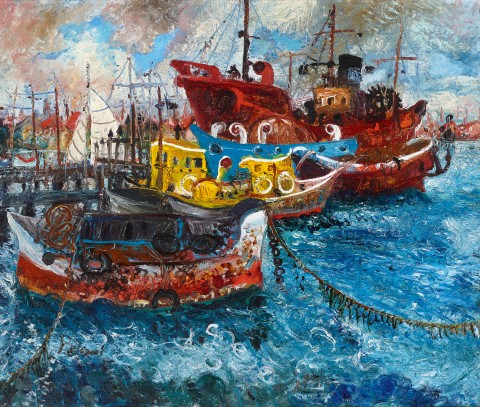OLD SHIPS AT WILLIAMSTOWN, 1959
JOHN PERCEVAL
oil on canvas on composition board
86.5 x 103.0 cm
signed lower left: Perceval
Australian Galleries, Melbourne
Miss Cara Black, Melbourne, acquired from the above in 1959
Sotheby’s, Melbourne, 24 July 1988, lot 408 (as ‘Boats at Williamstown’)
Private collection, Melbourne
John Perceval, Australian Galleries, Melbourne, 17 March 1959, cat. 17
John Perceval: A Retrospective Exhibition of Paintings, Heide Park and Art Gallery, Melbourne, 10 July – 26 August 1984, cat. 52, p. 23
John Perceval: A Retrospective Exhibition, National Gallery of Victoria, Melbourne, 30 April – 12 July 1992, Art Gallery of New South Wales, Sydney, 6 August – 20 September 1992 (label attached verso)
Allen, T., John Perceval, Melbourne University Press, Melbourne, 1992, p. 160
Perceval.jpg

Amidst the turbulent war years of the 1940s, the art patrons John and Sunday Reed gathered a coterie of artists and writers around them at their farm cottage ‘Heide’ in the northern suburbs of Melbourne. Known now and forever as the Angry Penguins, their number includes Sidney Nolan, Joy Hester, Albert Tucker, Arthur Boyd and the youngest, John Perceval. Through the combination of drive and ambition, they and the Reeds collectively set a highly influential course through the trajectory of Australian post-war modernism. Incredibly, none of the artists ever graduated from art school and some had never even set foot within such an institution. They were, for the most part, self-trained but were also voracious readers absorbing ideas, suggestions and techniques that fed directly into the art they were making. For all but Hester, the 1950s brought fame and wealth, and Perceval’s Old Ships at Williamstown, 1959, is the perfect example of why this occurred, a life-affirming and boisterous view of the otherwise run-down port on Port Phillip Bay.
There is a seductive appeal to the Williamstown paintings with their swirling paint, rich colours and tumbling imagery which led critics to use such terms as ‘joie de vivre’ and ‘untrammelled joy’ to describe Perceval’s work. The noted historian Bernard Smith went further and saw links with American ‘action’ painting. Perceval believed such descriptions were simplistic, taking pains to explain instead that ‘at all times my work is primarily a response to the subject, to light and trees, air, people etc. Whatever success it may achieve is due to the desire to equate the vitality, the pulse of life in nature and the world around us.’1 Perceval, as noted, was not academically trained but had shown early talent. Forced into hospital for a year by a bout of polio when he had just turned fifteen, his story and a self-portrait were featured in a newspaper article in 1938 titled ‘Paralysed boy of 15 paints like a master.’2 The journalist had met Perceval by chance whilst visiting the wards and was immediately struck by the boy’s creativity and art knowledge noting that here was somebody with ‘talent oozing out of them.’3 The article also prompted the well known painter and teacher Arnold Shore to visit, advising him that to be serious, he must ‘make a drawing a day and a painting a week.’4 By the time he was an adult, Perceval’s drawings were uniquely his own, the complete antithesis of rigid academic emphasis on proportion and perspective. Instead, his lines become an integral component of his graphic work, twisting and spinning around the page, revealing a distinct kinship between these drawn marks and those of his brush.
Boyd and Perceval.jpg

Perceval served in the army during the early years of the war where he met Arthur Boyd and one of the pivotal partnerships in Australian art was formed. His new friend came from a family of artists who embraced the young man to such as extent that he married Boyd’s younger sister Mary. Perceval and Boyd founded the renowned AMB Pottery in 1944 and simultaneously embarked on a series of paintings informed by biblical tales and myths, underpinned by a deep admiration for such northern European artists as Rembrandt and Breughel. To truly understand how these early masters achieved their results, Boyd and Perceval studied Max Doerner’s The Materials of the Artist and their Use in Painting, published in 1934, using the book’s salient advice as a basis for their own experimentation. Following negative comments about his landscapes by John Reed, Perceval ceased painting to focus on his pottery but following the purchase of a Volkswagen beetle, and with Charles Blackman as an occasional companion, he began to travel further around Melbourne. Together, they ‘discovered’ picturesque Williamstown in 1955 which, as Perceval exclaimed, was ‘like finding Venice.’5 The resultant paintings formed the core of his solo exhibition the following year with Australian Galleries, who used the event to launch their business. The Gallery’s co-director Anne Purves later recalled the ‘overwhelming’ impact on first seeing the Williamstown works ‘where the aquamarine waters were edged by white lace as they washed up against the granite rocks, which formed the small havens for fishing boats.’6 As with Purves, the paintings struck a deep and positive chord with critics and collectors alike, and much of their number are now held in the collections of Australia’s state and national galleries.
Perceval returned to Williamstown in 1959 and painted a second, smaller series. In these he employed a higher key in his colours than that used in the earlier images, seen to full effect in Old Ships at Williamstown. As before, there is a palpable energy to these paintings – even a tang of salt air and diesel – but at their core is the artist’s distinctive technique and rigorous self-training, evident is such passages as the perfectly serried dashes that articulate the weed on the foreground ship’s ropes. Perceval’s design sets the cluster of the rusting ships against the sail of a passing yacht and, in the distance, the low profile of Melbourne city, under a sky full of scudding clouds, choppy on a base of Anne Purves’ lacy waves.
1. John Perceval, cited in Reed, J., New Painting 1952 – 1962, Longmans, Melbourne, 1963, p. 24. Bernard Smith’s ‘action painting’ quote appears on p. 99
2. Pimlott, F. L., ‘Paralysed boy of 15 paints like a master’, The Sun News Pictorial, Melbourne, 25 June 1938, p. 43
3. F. L. Pimlott cited in Barrett Reid, Of Light and Dark: the art of John Perceval, National Gallery of Victoria, Melbourne, 1992, p. 10
4. Arnold Shore cited ibid., p. 9
5. Plant, M., John Perceval, Lansdowne Australian, Melbourne, 1971, p. 52
6. Anne Purves, unpublished memoirs cited in Field, C., Australian Galleries: the Purves family business. The first four decades 1956 – 1999, Australian Galleries, 2019, pp. 32-33
ANDREW GAYNOR
